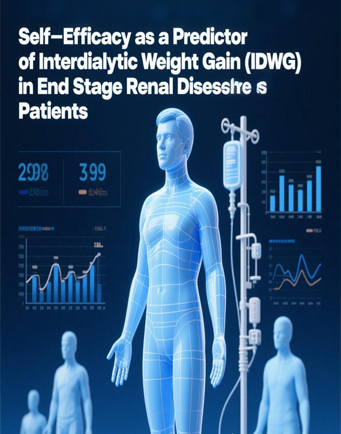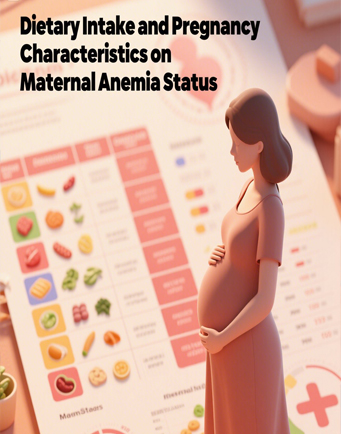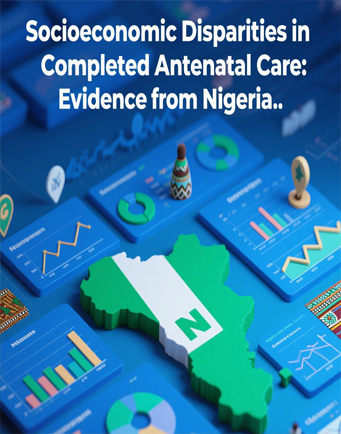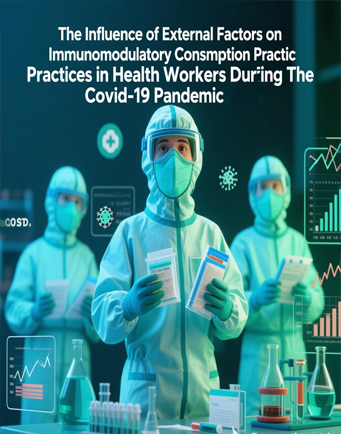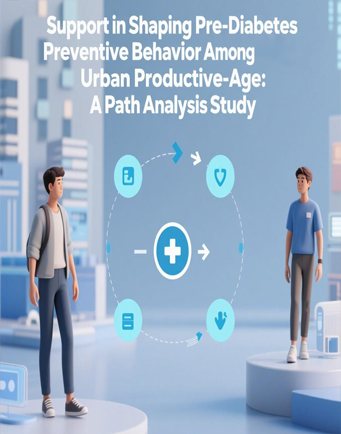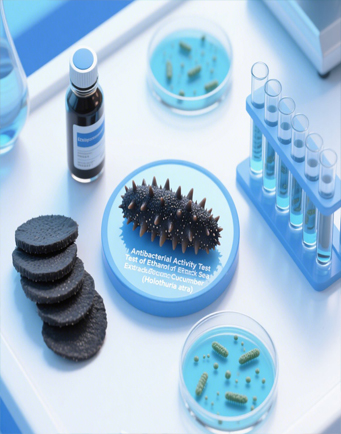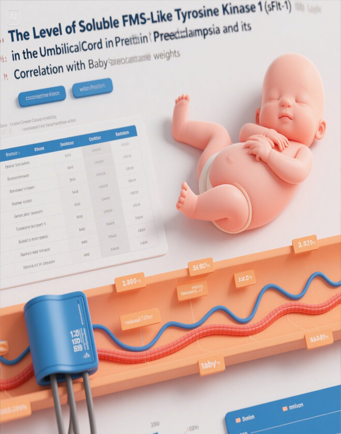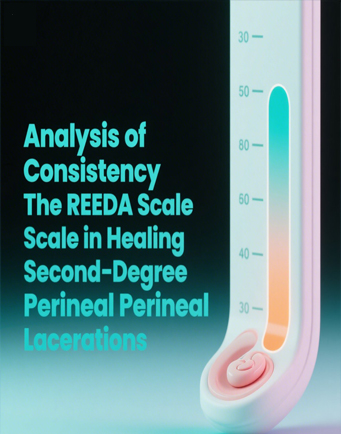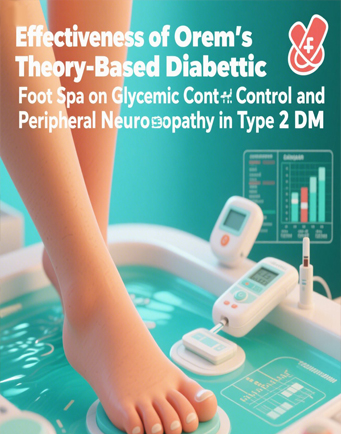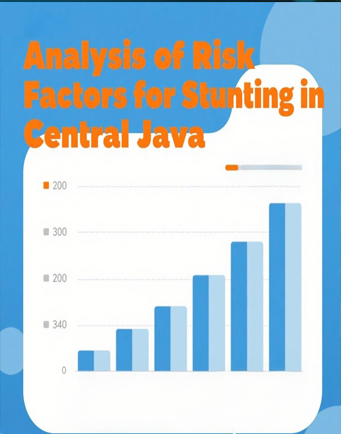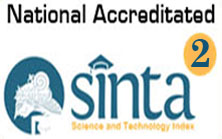Effectiveness of Drug Supervisors in Increasing Tuberculosis Prevention Actions and Consumption of Tuberculosis Drugs

Downloads
National tuberculosis control continues to be carried out by intensification, acceleration, extensification and program innovation. One of the efforts with an effective Directly observed treatment shortcourse (DOTS) strategy. The main focus of this strategy is the discovery and cure of patients and breaking the chain of Tuberculosis transmission so as to reduce the incidence and increase Tuberculosis cure in the community. This research aimed to assess the efficacy of Drug Supervisors in reducing transmission and ensuring adherence to Tuberculosis medication throughout treatment. The study used a quasi-experimental design using a pre-posttest framework, comprising an intervention group of 14 participants and a control group of 14 participants. The group of subjects was observed before the intervention, namely direct supervision of taking medication (PMO) through the DOTS strategy by family/relatives/caregivers/officers on TB patients during the treatment period and observed again after the intervention. The sample was selected based on sub-district sample clusters using proportional allocation techniques. Bivariate analysis applied independent t test and mann whitney test (value α = 0.05) because the distribution of the data obtained was not normal. This research revealed that patients receiving intervention in the form of drug monitoring by PMO experienced an increase in TB transmission prevention measures higher than the control group, thus compliance in taking medication was higher in the case group compared to the control group (p 0.01). This indicates that a PMO is essential for every patient receiving Tuberculosis therapy to prevent lack of follow-up and mitigate the influence on the onset of TB-MDR.
Aini, Z. M., & Rufia, N. M. (2019). Karakteristik Penderita Tuberculosis Multidrug Resistant (TB MDR) di Sulawesi Tenggara Tahun 2014-2017. Medula, 6(2), 547–557. https://doi.org/10.46496/medula.v6i2.6727
Ashari, A. E., Muslimin, I., & Malongi, A. (2020). The Strategy of Directly Observed Treatment Shortcourse (DOTS) Towards Compliance with Treatment of Tb Lung Patients in Tb Lung Mamuju District Hospital, Indonesia. Sys Rev Pharm, 11(6), 1185-1187. Retrieved from: https://www.sysrevpharm.org/abstract/the-strategy-of-directly-observed-treatment-shortcourse-dots-towards-compliance-with-treatment-of-tb-lung-patients-in-tb-66332.html#cite
Astuti, N., Djajakusumah, T., & Ibnusantosa, R. G. (2020). Scoping Review: Efektivitas Strategi Directly Observed Treatment Shortcourse (DOTS) pada Pengobatan Pasien Tuberkulosis. Prosiding Kedokteran, 7(1), 27–36.
Batbual, B., Wanti, W., Kusmiyati, K., Sambara, J., Irfan, I., Tat, F., Belarminus, P., & Charles, Y. (2021, November). The Association between Attitude and Adherence to Take Anti-Tuberculosis Drugs in Tuberculosis Patients in Kupang Health Center, East Nusa Tenggara, Indonesia. The International Conference on Public Health Proceeding, 6(1), 255-261. https://doi.org/10.26911/AB.Epidemiology.ICPH.08.2021.37
Bayan, U. A. Q., Prihanto, E. S. D., & Anwar, M. (2022). Karakteristik pasien Tuberkulosis Resistan Obat di RSUD Dr H. Chasan Boesoirie. Kieraha Medical Journal, 4(1), 15-21. https://doi.org/10.33387/kmj.v4i1.4409
De Fretes, F., Mangma, Y. E., & Dese, D. C. (2021). Analisa Peran Pengawas Minum Obat (PMO) Dalam Mendampingi Pasien Tuberkulosis di Kota Kupang. Jurnal Keperawatan Muhammadiyah, 6(3), 42–48. https://doi.org/10.30651/jkm.v6i3.9058
Dewi, S. W. (2021). Upaya Pengendalian Tuberkulosis dengan Meningkatkan Kepatuhan Minum Obat Anti Tuberkulosis. Media Kesehatan Masyarakat Indonesia, 20(3), 200–205. https://doi.org/10.14710/mkmi.20.3.200-205
Dinkes Kabupaten Ende. (2020). Profil Kesehatan Kabupaten Ende 2019. Dinkes Kabupaten Ende.
Dinkes Kabupaten Ende. (2022). Profil Kesehatan Kabupaten Ende Tahun 2021. Dinkes Kabupaten Ende.
Dirjen P2P Kemenkes RI. (2020). Kumpulan Ringkasan Kebijakan Policy Brief Riset Operasional Tuberkulosis. Kemenkes RI.
Fitria, E., Ramadhan, R., & Rosdiana, R. (2017). Karakteristik Penderita Tuberkulosis Paru di Puskesmas Rujukan Mikroskopis Kabupaten Aceh Besar. Sel Jurnal Penelitian Kesehatan, 4(1), 13-20.
Gunawan, Y. E. S., Njurumana, C. A., Njakatara, U. N., Landudjama, L., & Wanti, W. (2022). Cultural factors and family behavior in preventing the transmission of TB in The Nusa Tenggara Region, Indonesia. International Journal of Health Sciences, 6, 709-723. https://doi.org/10.53730/ijhs.v6ns9.12318
Handayani, D., Ramadhani, N., Samudera, A. G., & Ditasari, U. (2021). Dalam Rangka Mengoptimalkan Peran PMO Untuk Meningkatkan Kepatuhan Minum Obat di Puskesmas Beringin Raya. Abdimas Unwahas, 6(1), 26–30.
Herawati, M. H. (2021). Alternatif Penanggulangan Tuberkulosis (TBC): Wilayah Indonesia di Luar Sumatra dan Jawa-Bali. Jakarta: LIPI Press.
ILO. (2021). Informal Economy Workers and the Epidemics of HIV and TB. ILO. Retrieved from: https://www.ilo.org/global/topics/decent-work/lang--en/index.htm
Inayah, S., & Wahyono, B. (2019). Penanggulangan Tuberkulosis Paru dengan Strategi DOTS. HIGEIA (Journal of Public Health Research and Development), 3(2), 223-233. Retrieved from: https://journal.unnes.ac.id/sju/higeia/article/view/25499
Ismah, Z., & Novita, E. (2017). Studi karakteristik pasien tuberkulosis di puskesmas Seberang Ulu 1 Palembang. Unnes Journal of Public Health, 6(4), 218-224. https://doi.org/10.15294/ujph.v6i4.15219
Kementerian Kesehatan Republik Indonesia. (2021). Jadikan Penerus Bangsa Bebas TBC, Dimulai dari Diri Sendiri dan Keluarga [Internet]. Jakarta: Kementerian Kesehatan Republik Indonesia. Retrieved from: https://sehatnegeriku.kemkes.go.id/baca/umum/20210324/0137316/jadikan-penerus-bangsa-bebas-tbc-dimulai-dari-diri-sendiri-dan-keluarga/
Kementerian Kesehatan Republik Indonesia. (2021). Profil Kesehatan Indonesia 2020. Jakarta: Kementerian Kesehatan Republik Indonesia.
Kementerian Kesehatan Republik Indonesia. (2022). Global Tuberculosis Report 2021. Kementerian Kesehatan Republik Indonesia.
Kementerian Kesehatan Republik Indonesia. (2024). Profil Kesehatan Indonesia Tahun 2023. Jakarta: Kementerian Kesehatan Republik Indonesia.
Marçôa, R., Ribeiro, A. I., Zão, I., & Duarte, R. (2018). Tuberculosis and Gender – Factors Influencing the Risk of Tuberculosis among Men and Women by Age Group. Pulmonology, 24(3), 199–202. https://doi.org/10.1016/j.pulmoe.2018.03.004
Muthiah, A., Indraswari, N., & Sujatmiko, B. (2019). Karakteristik Pasien Tuberkulosis Lost to Follow Up dari Empat RS di Kota Bandung. Jurnal Epidemiologi Kesehatan Indonesia, 3(1), 25–34. https://doi.org/10.7454/epidkes.v3i1.3208
Narasimhan, P., Wood, J., MacIntyre, C. R., & Mathai, D. (2013). Risk factors for tuberculosis. Pulmonary medicine, 2013(828939), 1-11. https://doi.org/10.1155/2013/828939
Peer, V., Schwartz, N., & Green, M. S. (2023). Gender differences in tuberculosis incidence rates—A pooled analysis of data from seven high-income countries by age group and time period. Frontiers in Public Health, 10, 997025. https://doi.org/10.3389/fpubh.2022.997025
Pertiwi, D., & Herbawani, C. K. (2021). Pengaruh Pengawas Minum Obat terhadap Keberhasilan Pengobatan Pasien Tuberkulosis Paru: A Systematic Review. Jurnal Kesehatan Tambusai, 2(4), 168-175. https://doi.org/10.31004/jkt.v2i4.3036
Sari, M. T., Haflin, H., & Rahmaniyah, D. (2020). Karakteristik dan Upaya Pencegahan Penularan Pada Penderita Tuberkulosis Paru. Jurnal Ilmiah Universitas Batanghari Jambi, 20(2), 692–696. https://doi.org/10.33087/jiubj.v20i2.1009
Wanti, W., Agustina, A., Singga, S., & Respati, T. (2022). Physical Environmental Conditions and Germ Number in Bedroom of Tuberculosis Patients in Kupang City, East Nusa Tenggara Province. Global Medical & Health Communication (GMHC), 10(2), 122–127. https://doi.org/10.29313/gmhc.v10i2.10144
Wanti, W., Rahmawati, E., Cahyani, S. L., Suluh, D. G., Sinaga, E.R., Agustina, A., & Singga, S. (2023). Relationship of Individual Characteristics and Behavior with the Tuberculosis Prevalence in Kupang City. Proceeding International Health Conference Poltekkes Kemenkes Padang, 3 (July), 205–209. Retrieved from: https://proceedinginternational.poltekkespadang.ac.id/index.php/jd/article/view/32
WHO. (2021). Global Tuberculosis Report 2021. WHO Retrieved from: https://www.who.int/publications/i/item/9789240037021
Wuan, A. O., Tangkelangi, M., Ketut, N., & Sari, Y. (2020). Validity of Exami̇nati̇on of Comple Speci̇fi̇c Anti̇gen Immunochromatography Method İn Pati̇ents Wi̇th Pulmonary Tuberculosi̇s. Journal of Social Reserach, 2(4), 1217–1222.
Yanti, N. L. D., Jati, S. P. ., & Arso, S. P. . (2024). Peran Dan Efektivitas Pengawas Minum Obat (PMO) Dalam Pengobatan Tuberkulosis: Scoping Review. PREPOTIF : Jurnal Kesehatan Masyarakat, 8(3), 7142–7152. https://doi.org/10.31004/prepotif.v8i3.37809
Zulfa, N. R. A., & Prihartono, N. A. (2023). Karakteristik Pasien Tuberkulosis di Kota Bandung Tahun 2021. Jurnal Integrasi Kesehatan & Sains (JIKS), 5(2), 155–158. https://doi.org/10.29313/jiks.v5i2.11804
Copyright (c) 2025 JURNAL INFO KESEHATAN

This work is licensed under a Creative Commons Attribution-NonCommercial-ShareAlike 4.0 International License.
Copyright notice
Ownership of copyright
The copyright in this website and the material on this website (including without limitation the text, computer code, artwork, photographs, images, music, audio material, video material and audio-visual material on this website) is owned by JURNAL INFO KESEHATAN and its licensors.
Copyright license
JURNAL INFO KESEHATAN grants to you a worldwide non-exclusive royalty-free revocable license to:
- view this website and the material on this website on a computer or mobile device via a web browser;
- copy and store this website and the material on this website in your web browser cache memory; and
- print pages from this website for your use.
- All articles published by JURNAL INFO KESEHATAN are licensed under the Creative Commons Attribution 4.0 International License. This permits anyone to copy, redistribute, remix, transmit and adapt the work provided the original work and source is appropriately cited.
JURNAL INFO KESEHATAN does not grant you any other rights in relation to this website or the material on this website. In other words, all other rights are reserved.
For the avoidance of doubt, you must not adapt, edit, change, transform, publish, republish, distribute, redistribute, broadcast, rebroadcast or show or play in public this website or the material on this website (in any form or media) without appropriately and conspicuously citing the original work and source or JURNAL INFO KESEHATAN prior written permission.
Permissions
You may request permission to use the copyright materials on this website by writing to jurnalinfokesehatan@gmail.com.
Enforcement of copyright
JURNAL INFO KESEHATAN takes the protection of its copyright very seriously.
If JURNAL INFO KESEHATAN discovers that you have used its copyright materials in contravention of the license above, JURNAL INFO KESEHATAN may bring legal proceedings against you seeking monetary damages and an injunction to stop you using those materials. You could also be ordered to pay legal costs.
If you become aware of any use of JURNAL INFO KESEHATAN copyright materials that contravenes or may contravene the license above, please report this by email to jurnalinfokesehatan@gmail.com
Infringing material
If you become aware of any material on the website that you believe infringes your or any other person's copyright, please report this by email to jurnalinfokesehatan@gmail.com.


